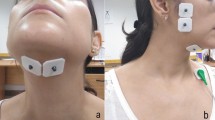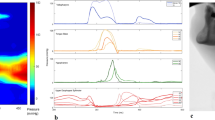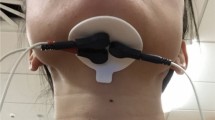Abstract
This study sought to determine whether effortful saliva swallows could be differentiated from habitual, noneffortful saliva swallows on the basis of swallow-related changes in neck circumference in humans. Gender differences in swallow-related neck circumference were examined as a secondary question. Twenty-seven healthy adults (14 females; mean age = 26.6 years, SD = 3.9 years) participated in two experimental runs (run duration = 10 min) during which they produced single trials of three visually cued tasks in random order: effortful saliva swallowing, saliva swallowing, and a control task involving repetitive apposition of the dominant thumb and index finger. Neck and ribcage circumference were simultaneously collected from the output of force transducers positioned around the neck and ribcage, respectively. The primary outcome variables were the positive and negative voltage peak amplitudes associated with changes in neck circumference during single-swallow trials. Effects of the swallowing task on positive and negative voltage peaks were examined with separate two-way analysis of variance procedures. Results indicated that both positive (F = 6.49, p < 0.05) and negative (F = 12.05, p < = .05) voltage peaks were significantly greater for effortful swallows compared with those for noneffortful swallows. The gender main effect and the swallow type by gender interaction were not significant. Effortful and noneffortful swallows of saliva can be differentiated from the output of a noninvasive force transducer worn around the neck. This type of physiologic recording may have potential as a biofeedback technique in training dysphagic patients on the effortful swallow maneuver.



Similar content being viewed by others
References
Logemann JA. Evaluation and treatment of swallowing disorders. 2nd edn. Austin TX: Pro-Ed; 1998. p. 221.
Veis S, Logemann JA, Colangelo L. Effects of three techniques on maximum posterior movement of the tongue base. Dysphagia 2000;15:142–5.
McConnel F. Analysis of pressure generation and bolus transit during pharyngeal swallowing. Laryngoscope 1998;98:71–8.
Dejaeger E, Pelemans W, Ponette E, Joosten E. Mechanisms involved in postdeglutition retention in the elderly. Dysphagia 1997;12:63–7.
Bülow M, Olsson R, Ekberg O. Videomanometric analysis of supraglottic swallow, effortful swallow, and chin tuck in healthy volunteers. Dysphagia 1999;14:67–72.
Hind JA, Nicosia MA, Roecker EB, Carnes ML, Robbins J. Comparison of effortful and noneffortful swallows in healthy middle-aged and older adults. Arch Phys Med Rehabil 2001;82:1661–5.
Huckabee ML, Butler SG, Barclay M, Jit S. Submental surface electromyographic measurement and pharyngeal pressures during normal and effortful swallowing. Arch Phys Med Rehabil 2005;86:2144–9.
Pouderoux P, Kahrilas PJ. Deglutitive tongue force modulation by volition, volume, and viscosity in humans. Gastroenterology 1995;108:1418–26.
Steele CM, Huckabee ML. The influence of orolingual pressure on the timing of pharyngeal pressure events. Dysphagia 2007;22:30–6.
Hiss SG, Huckabee ML. Timing of pharyngeal and upper esophageal sphincter pressures as a function of normal and effortful swallowing in young healthy adults. Dysphagia 2005;20:149–56.
Lazarus C, Logemann JA, Song CW, Rademaker AW, Kahrilas PJ. Effects of voluntary maneuvers on tongue base function for swallowing. Folia Phoniatr Logop 2002;54:171–6.
Bülow M, Olsson R, Ekberg O. Videomanometric analysis of supraglottic swallow and chin tuck in patients with pharyngeal dysfunction. Dysphagia 2001;16:190–5.
Bülow M, Olsson R, Ekberg O. Supraglottic swallow, effortful swallow, and chin tuck did not alter hypopharyngeal intrabolus pressure in patients with pharyngeal dysfunction. Dysphagia 2002;17:197–201.
Crary MA. A direct intervention program for chronic neurogenic dysphagia secondary to brainstem stroke. Dysphagia 1995;10:6–18.
Huckabee ML, Cannito M. Outcomes of swallowing rehabilitation in chronic brainstem dysphagia: a retrospective evaluation. Dysphagia 1999;14:93–109.
Barofsky I. Surface electromyographic biofeedback and the patient with dysphagia: clinical opportunities and research questions. Dysphagia 1995;10:19–21.
Bryant ML. Biofeedback in the treatment of a selected dysphagia patient. Dysphagia 1991;6:140–4.
Schmidt RA, Wrisberg CA. Motor learning and performance: a problem-based learning approach. 3rd edn. Champaign IL: Human Kinetics; 2004.
Hummel FC, Cohen LG. Drivers of brain plasticity. Curr Opin Neurol 2005;18:667–74.
Ekberg O. The normal movements of the hyoid bone during swallow. Invest Radiol 1986;21:408–10.
Ishida R, Palmer JB, Hiiemae KM. Hyoid motion during swallowing: factors affecting forward and upward displacement. Dysphagia 2002;17:262–72.
Logemann JA, Pauloski BR, Rademaker AW, Kahrilas RT. Oropharyngeal swallow in younger and older women: videofluoroanalysis. J Speech Lang Hear Res 2002;45(3):434–45.
Author information
Authors and Affiliations
Corresponding author
Rights and permissions
About this article
Cite this article
Coulas, V.L., Smith, R.C., Qadri, S.S. et al. Differentiating Effortful and Noneffortful Swallowing with a Neck Force Transducer: Implications for the Development of a Clinical Feedback System. Dysphagia 24, 7–12 (2009). https://doi.org/10.1007/s00455-008-9157-0
Received:
Accepted:
Published:
Issue Date:
DOI: https://doi.org/10.1007/s00455-008-9157-0




